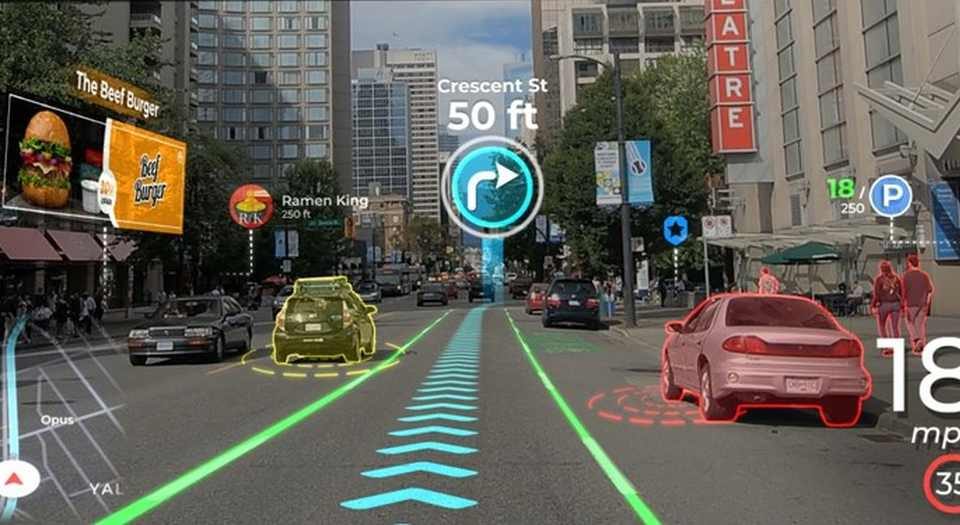Augmented Reality (AR) is reshaping the way we learn, shop and even experience entertainment. AR creates a new way of how we interact with the world around us by blending digital content with our real physical surroundings. From virtual fitting rooms in the fashion industry to the new learning tools that revolutionize education (Bacca et al., 2014). AR is also transforming the way we navigate – whether you walk through a crowded city or drive on unfamiliar roads. AR-based navigation tools make it easier, and even more important, also safer to move through different environments.
A perfect example of the use of AR in navigation is Google Maps’ AR walking directions. This initiative uses overlayed arrows and street names in the real-world view that is captured by the camera of our phones. This feature makes navigation simpler by providing visual aspects to guide users in busy urban spaces for example. This function reduces the confusion that is often associated with traditional map interfaces (Google, 2023). Indoors, AR can also make an impact in the way we navigate. Blippar’s AR navigation helps users to find their way through complex indoor spaces like malls or airports. It overlays digital directions on our smartphone screens (Blippar, 2023). This technology is particularly useful in environments where traditional GPS signals are weaker.
In the automotive world, the company WayRay used AR head-up displays (HUDs). These systems can project navigational information directly onto the windshield of a vehicle. This allows drivers to receive direction instructions without diverting their attention from the road. WayRay uses holographic optical elements (HOEs) in their displays, these can handle complex optical tasks while staying thin, clear, and flexible enough to fit curved surfaces like windshields (WayRay, 2023). This innovation improves safety by reducing distractions. This can make AR navigation more integrated and intuitive.
As AR technology advances, we can expect to see even more immersive and hands-free navigation experiences in the future, such as AR glasses that guide users in real time (Billinghurst et al., 2015). While there are still quite some challenges, like data accuracy and user adoption, AR will undoubtedly lead the next evolution of navigation.
References
Bacca, J., Baldiris, S., Fabregat, R., Graf, S., & Kinshuk. (2014). Augmented reality trends in education: A systematic review of research and applications. Educational Technology & Society, 17(4), 133-149. https://www.jstor.org/stable/jeductechsoci.17.4.133
Billinghurst, M., Clark, A., & Lee, G. (2015). A survey of augmented reality. Foundations and Trends in Human-Computer Interaction, 8(2-3), 73-272. https://doi.org/10.1561/1100000049
Blippar. (2023). AR indoor navigation. Retrieved from https://www.blippar.com
Google. (2023). Google Maps AR walking directions. Retrieved from https://www.google.com/maps
Huang, B. C., Hsu, J., Chu, E. T. H., & Wu, H. M. (2020). Arbin: Augmented reality based indoor navigation system. Sensors, 20(20), 5890.
Narzt, W., Pomberger, G., Ferscha, A., Kolb, D., Müller, R., Wieghardt, J., … & Lindinger, C. (2006). Augmented reality navigation systems. Universal Access in the Information Society, 4, 177-187.
WayRay. (2023). AR head-up displays for cars. Retrieved from https://www.wayray.com


Your post offers a comprehensive look at how Augmented Reality (AR) is transforming navigation in various contexts, and I love the examples you’ve provided! The way AR seamlessly integrates digital content with our physical surroundings is indeed revolutionary.
The discussion about Google Maps’ AR walking directions is particularly compelling. It’s fascinating how visual cues can enhance our navigation experience, especially in bustling urban environments where traditional maps can often be overwhelming. Similarly, Blippar’s indoor navigation tools fill a significant gap by addressing the limitations of GPS in complex spaces—a real game-changer for large venues like shopping malls and airports.
I also appreciate your mention of WayRay’s AR head-up displays. This innovation not only makes navigation more intuitive but also prioritizes driver safety by minimizing distractions. It raises an interesting point about how AR can redefine our relationship with technology while still keeping us connected to our surroundings.
However, I’m curious about the more nuanced challenges you briefly touched upon, like data accuracy and user adoption. As AR becomes more integrated into our daily lives, ensuring that the information provided is reliable will be crucial. Additionally, I wonder how we can encourage users to embrace these technologies, especially those who may be hesitant or unfamiliar with AR.
Looking ahead, the idea of AR glasses providing real-time guidance is exciting, but it also raises questions about privacy and the potential for information overload. How do you see the balance between enhancing navigation experiences and maintaining user comfort with technology?
Overall, your insights highlight the immense potential of AR in navigation, and I’m eager to see how this technology evolves!
I remember when we got lost in the narrow, winding streets of Jodhpur in India. The traditional map apps just couldn’t capture the complexity of the layout, and we ended up asking locals for directions. If we’d had AR maps, it would’ve made things so much easier by overlaying real-time directions to guide us through the chaos! I can totally relate to the article when it says AR makes navigation simpler by providing visual aspects to guide users in busy urban spaces. That’s exactly what we needed on that trip.
It’s exciting to think about how AR can revolutionize navigation, not just outdoors but indoors too. I’ve often struggled to find my way in large malls or airports, and AR could be a game-changer for those moments. With AR tech like Blippar’s indoor navigation, getting through complex spaces would be a breeze.